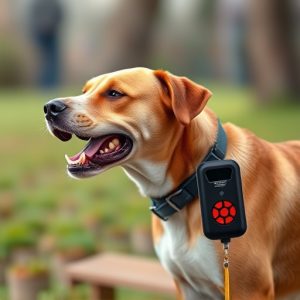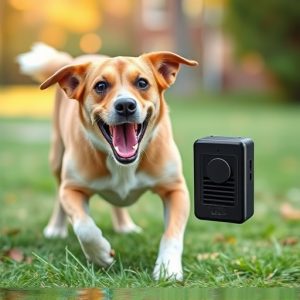Electronic Pet Deterrents: Safety, Benefits, and Effective Use Guide
Sonic dog deterrents, electronic pet deterrents designed to protect against aggressive canines, oper…….
Sonic dog deterrents, electronic pet deterrents designed to protect against aggressive canines, operate within strict safety regulations covering power output, frequency ranges, and sound pressure levels. These regulations are crucial for standardizing safety protocols in the rapidly growing electronic pet deterrent market. By adhering to these guidelines, sonic dog deterrents offer a humane and effective solution for managing canine behavior in various settings while ensuring responsible use and animal welfare. Their effectiveness hinges on optimal frequency levels, programmed triggers, and reward systems for consistent fine-tuning. Global safety regulations like FDA standards govern these devices, protecting both pets and users from potential harm.
“Explore the world of sonic dog deterrents—innovative solutions for pet owners seeking safe and effective protection while walking their dogs. This comprehensive guide delves into the science behind these electronic devices, offering a detailed look at their operation and benefits. We navigate the essential considerations regarding Electronic Pet Deterrent Safety Regulations, providing an in-depth analysis to ensure informed choices. From understanding their mechanism to comparing them with traditional methods, this article covers all you need to know about sonic dog deterrents.”
- Understanding Sonic Dog Deterrents: How They Work
- Electronic Pet Deterrent Safety Regulations: A Comprehensive Overview
- Benefits and Applications of Sonic Dog Deterrents
- Implementation and Training: Ensuring Effective Use
- Comparative Analysis: Traditional vs. Electronic Dog Deterrents
Understanding Sonic Dog Deterrents: How They Work
Sonic dog deterrents are innovative devices designed to protect pets and their owners from potentially harmful encounters with aggressive dogs. These electronic pet deterrents emit high-frequency sound waves that are harmless to humans but can be unpleasant for canines, encouraging them to stay away from specific areas. The technology is based on the principle of creating an effective barrier without causing any physical harm.
The devices operate under strict safety regulations, ensuring they meet specific criteria for electronic pet deterrents. These regulations cover factors like sound pressure levels, frequency ranges, and power output to guarantee user and pet safety. By adhering to these guidelines, sonic dog deterrents offer a humane and effective solution for managing and preventing dog aggression during walks.
Electronic Pet Deterrent Safety Regulations: A Comprehensive Overview
The market for electronic pet deterrents, especially those designed for dogs, has seen significant growth in recent years. However, with this rise comes a crucial need for comprehensive Electronic Pet Deterrent Safety Regulations to ensure these devices are safe and effective for both pets and their owners. Such regulations are essential to standardize safety protocols and protect consumers from potentially harmful products.
These regulations should cover various aspects, including device design, testing procedures, and labeling requirements. For instance, they must ensure that electronic deterrents emit safe sound levels, avoiding any potential hearing damage to animals. Additionally, guidelines on energy output and shock intensity are vital to prevent physical harm. Proper testing protocols will verify these safety standards, ensuring only compliant products reach the market. Clear and concise labeling, detailing usage instructions, potential risks, and animal compatibility, will empower pet owners to make informed decisions, enhancing overall product safety.
Benefits and Applications of Sonic Dog Deterrents
Sonic dog deterrents, also known as electronic pet deterrents, offer a humane and effective solution for managing canine behavior in various settings. These devices emit high-frequency sound waves that are unpleasant to dogs but harmless to humans and other animals. One of the primary benefits is their versatility; they can be used outdoors to protect gardens, patios, and walkways from dog intrusions without causing any physical harm. This makes them ideal for homeowners seeking a non-lethal alternative to traditional deterrents like spray or electric fences.
Additionally, electronic pet deterrents are subject to safety regulations, ensuring their responsible use. These regulations cover aspects like frequency range, intensity limits, and testing procedures to guarantee user and pet safety. They are particularly useful in public spaces like parks and hiking trails, where controlling dog behavior is essential for maintaining order and preventing disturbances. By using sonic deterrents, communities can foster a more peaceful environment without compromising animal welfare.
Implementation and Training: Ensuring Effective Use
Implementing an electronic pet deterrent, such as a sonic dog deterrent, requires careful training for both the device and its user. Users must understand how to operate the device effectively while adhering to local Electronic Pet Deterrent Safety Regulations. This includes setting the correct frequency levels to avoid disturbing neighbouring animals or people, and programming the device with specific triggers relevant to dog behaviour, like excessive barking or approaching certain areas.
Training also involves teaching pets positive associations with the deterrent’s activation. Reward systems can be employed during training sessions to reinforce calm behaviour when the device is triggered. Consistent use in controlled environments allows for fine-tuning the settings and responses, ensuring the device remains effective over time while minimising any potential harm or stress to pets.
Comparative Analysis: Traditional vs. Electronic Dog Deterrents
In the realm of pet care and safety, dog deterrents have evolved from traditional methods to electronic innovations, each with its merits and drawbacks. Traditional dog deterrents often rely on physical barriers or manual intervention, such as noise makers or spray-based repellents. These methods are usually straightforward, cost-effective, and don’t require any specific training for the dogs or owners. However, they may not be reliable in all situations, especially when dealing with persistent or aggressive dogs.
Electronic pet deterrents, on the other hand, leverage advanced technology like ultrasonic sound waves, electric shocks (within safe limits), or scent-based repellents. These devices are designed to minimize harm while effectively training and deterring dogs from unwanted behaviors. Safety regulations for electronic pet deterrents vary globally but generally focus on ensuring they meet specific safety standards, such as those set by the FDA or similar bodies. These regulations cover factors like voltage levels, frequency ranges, and material safety, underscoring the importance of responsible innovation in this space to protect both pets and users.
Sonic dog deterrents offer a modern, non-lethal approach to keeping dogs away from sensitive areas, with their effectiveness backed by scientific research. When used responsibly and in adherence to electronic pet deterrent safety regulations, these devices can significantly enhance public safety while fostering a harmonious coexistence between humans and canine companions. By understanding how they work, their benefits, and proper implementation, individuals can make informed decisions about incorporating this innovative technology into their communities.


